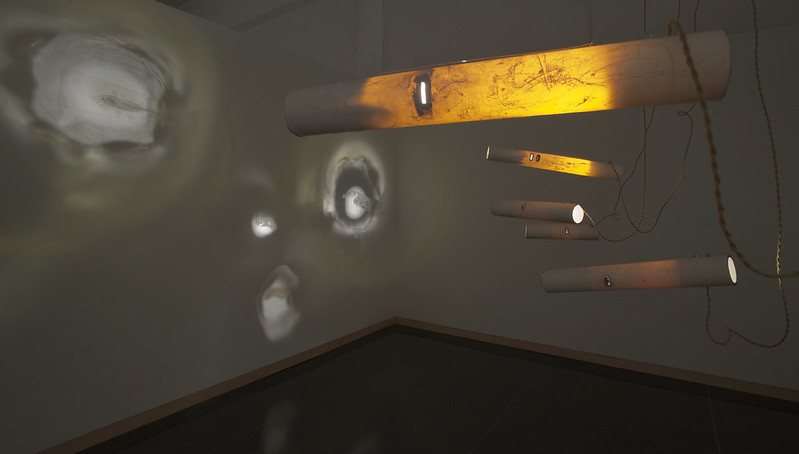The shape and texture of these irradiating lights are simultaneously inspired by hairy veins, pulsing organs and medical imaging devices. Glass slides, from Toxic Remedies: Micro Drawings, inserted in the tubes reveal quivering illuminations which are simple but illusive in their distortion and exaggeration of imagined specimens. Click here to read the Foreign Bodies Press Release a two person exhibition in which Toxic Remedies was exhibited.
Toxic Remedies: Description by Kara Jefts
Caitlin Foley’s installation, Toxic Remedies, employs mixed media to create an environment that refers to the artist’s perception of our internal bodies. The installation consists of five tube-shaped projectors suspended in the center of the gallery, casting drawn images onto a blank wall.
The projected images are from small glass slides, the type used to view specimens under a microscope. The collection of slides is lined in rows on a table neighboring the installation, allowing the viewer to closely scan dozens of samples. Inspired by images and descriptions sourced from “self-diagnosis” Internet searches, the slides are host to a variety of viruses, bacteria, and transfigured organs. Foley has re-envisioned the specimens, drawing them with delicate pencil line over color washes on the small glass surfaces. Most slides contain indiscernible organic forms, allowing the viewer to conjure from their own imagination what each sample might represent. Other slides reveal recognizable parts of the anatomy: a sutured finger, a disemboweled torso. These representations are not, however, intended to be gruesome. Both the drawing style and the choice of color – markedly void of blood red – make the samples easy to view.
In her statement Foley notes that she changes the slides periodically, rotating the samples to be projected within the space. Once projected, the flat drawings on the slides are transformed into large, imposing, and dimensional organic forms. The images move and quiver as they are projected from the tubes that dangle from the ceiling. The edge of the projected light is not a sharp line, but instead creates a pleasing rippled effect, a result of light refracted from reflective materials within the suspended tubes.
The system Foley devised for the projection of the slides creates a sculptural dimension within the installation space. Winding electrical wires climb to the ceiling, reminiscent of vascular systems; and the segmented tubes projecting the images glow warmly, revealing a textured surface much like the fibrous composition of musculature.
The transformation of these imagined organic forms, from small intricate drawings to the ghosted images slightly fluttering along the wall, heightens the senses. Once projected, the playful slide drawings become menacing – the enlarged scale, movement, and the sculptural construction within the space confront the viewer. They become parasites of the physical space within the gallery in the same way we might imagine a disease to be invading the inner landscape of our own body. Entering Foley’s installation, Toxic Remedies, the viewer is encouraged to experience a new corporeality.
